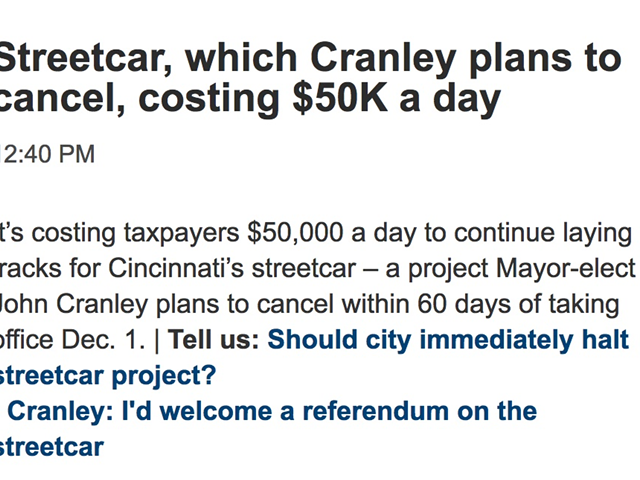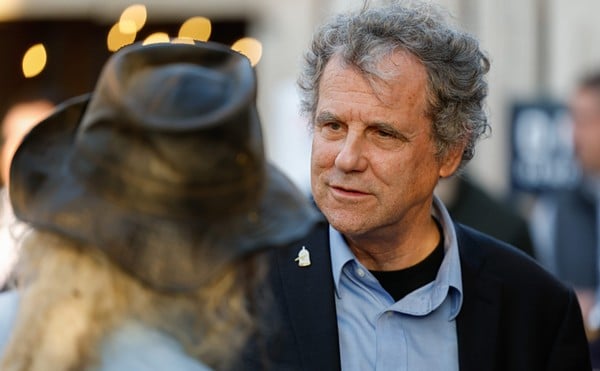City officials on Wednesday reasserted that it remains unknown how much it would cost to cancel the $133 million streetcar project, and city spokesperson Meg Olberding and project executive John Deatrick agreed the unknown costs are a big concern.
Voters on Tuesday elected John Cranley to the mayor’s office and six council members — out of nine total — who oppose the streetcar project, giving streetcar opponents enough votes to cancel the project once the new government takes power on Dec. 1.
first reported by CityBeat on Oct. 9
, cancellation could carry all sorts of costs with $94 million tied to contractual obligations, including supply orders and other expenses from contractors and subcontractors, and $23 million already sunk on the project.
If the city were to cancel, it would also need to return nearly $41 million in grants to the federal government, according to a June 19 letter from the U.S. Department of Transportation.
Canceling the project would cost jobs as well. About 150 laborers are currently working on the project, according to Deatrick. He says there’s also management positions involved, but he couldn’t offer an estimate for those jobs and whether they’re working on the project full- or part-time.
Deatrick says that it’s difficult to pin down how much cancellation would ultimately cost because the issue would likely be worked through litigation as the city tries to minimize cancellation costs and developers — such as Messer Construction, Prus Construction, Delta Railroad and CAF USA — attempt to maximize what they recoup from the project.
Another concern, according to Olberding, is cancellation’s impact on the operating budget. She says the roughly $2 million in federal grant money already spent on the project would have to come out of the operating budget, and litigation costs would come from the operating budget as well.
The capital budget, which is financed through bonds and other forms of debt, pays for capital projects like the streetcar. The operating budget typically goes toward day-to-day operations, including police, firefighters and human services.
The operating budget has been structurally imbalanced since 2001. If millions in litigation costs and repayments to the federal government are added to it, the city could be forced to cut services and jobs or raise taxes.
There are also concerns about how the federal government and Cincinnati’s business partners would react to the cancellation of such a major project. Vice Mayor Roxanne Qualls, Cranley’s opponent in the mayoral race, previously told CityBeat that pulling back on a commitment could break the faith developers and the feds placed in Cincinnati when they agreed to take on the streetcar project.
Cranley and other anti-streetcar elects argue the long-term costs — the $88 million in the capital budget for the current phase of the project, the cost of future expansion and $3-4 million that it would cost to operate the streetcar annually — outweigh even the costs of cancellation.
Cranley previously told CityBeat that he would help developers involved in the project find other work in the city to recoup the revenue lost from the project’s cancellation. He says Messer and Prus in particular are based in and already work heavily in Cincinnati, so it’s unlikely they would try to cut ties with the city.
Streetcar supporters aren’t convinced. If the city pulls out of such a big commitment, officials argue both the federal government and developers could be compelled to look for a more reliable source for future work.
Meanwhile, Deatrick says current construction work is progressing on time and within budget. He expects the track on Elm Street to be laid down between 12th and Henry streets by the end of the year.
As for the next phase of the project, Deatrick says there’s still no estimated cost. He attributes much of the project’s current political problems to construction bids coming in over budget earlier in the year — a turn of events that led City Council to put another $17.5 million to the streetcar project — so he says the city needs to be really careful with future estimates if it decides to expand the streetcar system.
Despite the fresh political threats, the city still intends to conduct meetings with businesses on Nov. 14 and 18 about the benefits of the streetcar. Deatrick says those meetings should show the economic benefits of the rail line that go beyond the streetcar’s use as a transit network.
Supporters of the streetcar often point to those benefits as their reasoning for backing the project. Citing a 2007 study from consulting firm HDR that was later evaluated and supported by the University of Cincinnati, supporters say the streetcar project would produce a three-to-one return on investment.
Deatrick acknowledges those projections are now outdated, given all the changes the project has gone through since 2007. He says the city has people working on updating the numbers and looking at other economic effects the HDR study may have missed.
But opponents of the streetcar project say it’s simply too expensive and the wrong priority for Cincinnati. Still, the potentially high cost of cancellation could prove a bigger fiscal concern.
Either way, Cincinnati should find out the full consequences to the project in December.






